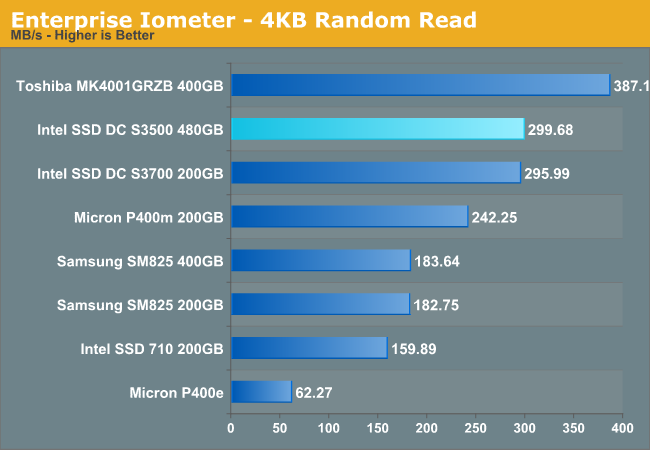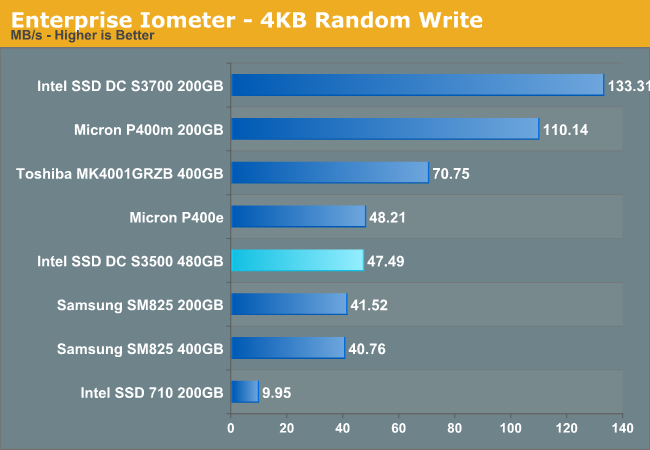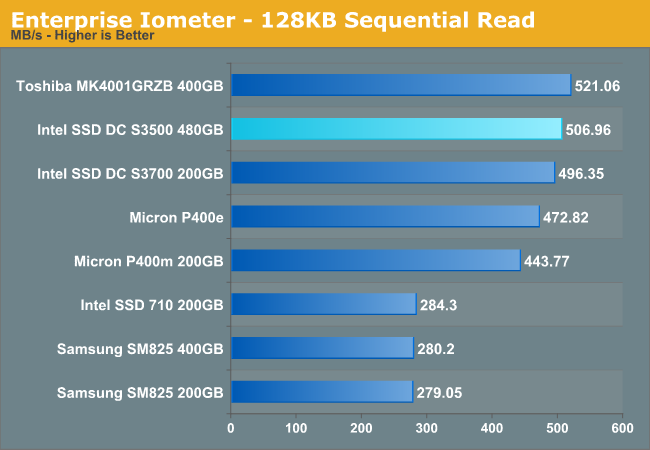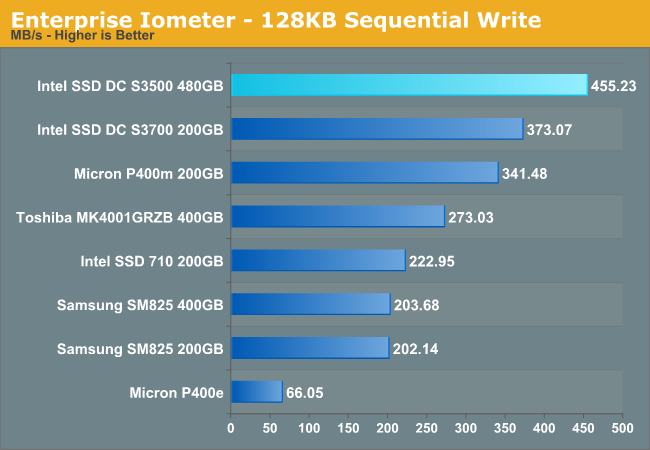Intel SSD DC S3500 Review (480GB): Part 1
by Anand Lal Shimpi on June 11, 2013 6:10 PM EST- Posted in
- Storage
- IT Computing
- SSDs
- Intel
- Datacenter
- Enterprise
Random & Sequential IO Performance
Similar to our other Enterprise Iometer tests, queue depths are much higher in our Iometer benchmarks. To measure sequential performance I ran a 1 minute long 128KB sequential test over the entire span of the drive at a queue depth of 32. For random performance, I ran a 3 minute long 4KB random read test over the entire span of the drive at a queue depth of 32. Random write performance was measured at steady state (QD32), which varies depending on capacity and other factors. The results reported are in average MB/s over the entire test length.

Random read performance is just excellent. The S3500 gives up nothing compared to the S3700 and ends up being one of the fastest enterprise drives we've tested.

Random write performance takes a big hit compared to the S3700. At 47MB/s, the S3500 isn't bad but it's not class leading like the S3700.

Sequential read speed is limited by 6Gbps SATA, and the S3500 has no issues hitting that limit given the number of NAND die inside the 480GB model. It's not until you get down to the 160GB version that performance will drop below 500MB/s.

Sequential write performance is substantially better on the S3500, making this drive even better for large sequential caching applications.










54 Comments
View All Comments
oyabun - Wednesday, June 12, 2013 - link
I made the same observation, the Samsung has at a minimum the performance of the Intel drive and then skyrockets.cheeselover - Wednesday, June 12, 2013 - link
umm... isn't it the other way around? 600pro already has overprovisioning at 28% and s3500 has it at 9%.btb - Wednesday, June 12, 2013 - link
No Windows 8 Secure boot support?btb - Wednesday, June 12, 2013 - link
oops typo, meant Microsoft eDrive supportlyeoh - Wednesday, June 12, 2013 - link
Anand, do you have IOPs/latency over time graphs for random reads as well? Or are random reads quite stable and we can derive them from the 4KB random read IO meter scores? I notice the sandforce drives seem to find random reads harder, so I'm wondering if there are any latency spikes for various drives.lucasbakker - Wednesday, June 12, 2013 - link
What about Capacitors on this controller? Why is it that nowadays in reviews I don't see any mention anymore about supercapacitors and data loss when losing power.ShieTar - Wednesday, June 12, 2013 - link
Well, those are enterprise drives, Intel probably assumes that their customers will implement their own emergency power plans in their data centers, so the drives itself don't have to.And on consumer drives, the potential data loss of a power outage are rather acceptable for most people. I've personally experienced one real power outage and one blown fuse over the next 25 years, so that's not really a relevant scenario for my PC buying decisions.
lucasbakker - Wednesday, June 12, 2013 - link
It used to be a big issue in reviews. For databases a capacitor can be pretty important, even when taking emergency power setups in mind. Furthermore, I guess that with laptops sudden power drops are a little bit more common.thomas-hrb - Wednesday, June 12, 2013 - link
Somehow I don't see this making it into too many laptops, and enterprise SAN's etc have power failure protection. I think that it is just a feature that was in the S3700 that they did not disable in this unit, it all helps with the prosumer targeting.zanon - Wednesday, June 12, 2013 - link
Um, Anand? Why no mention of your own research showing how key over provisioning was and the immense difference it could make in performance consistency? The S3500 is significantly more expensive then other prosumer drives like the 840 Pro, Corsair Neutron, etc., and by "significant" I mean the magical "25%". That means that someone could instead choose to get another drive (or multiple other drives) and then assign 25% spare area for each, at which point from your own tests it looks like the S3500 gets SLAUGHTERED.Please do not throw softballs to Intel, they are big boys and can and should be expected to produce competitive, top tier stuff with no asterisks. If for some reason the far higher IOPS with better consistency produced by drives like the Corsair aren't worth the same as the Intel drive, please explain why. If there are other special features being factored in, please mention them. But even for a brief, high level overview this didn't feel like it set the proper context. You spent a great deal of time testing and discussing this stuff in the past, so to suddenly have it vanish from the conversation feels pretty weird.